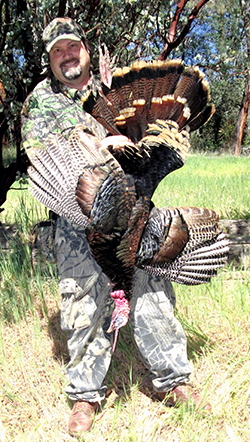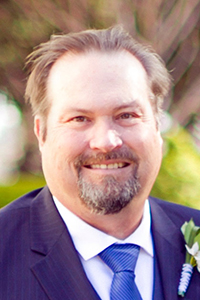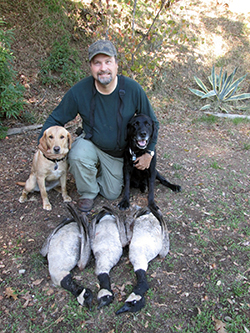Dr. Andrew Gordus has a unique position, as he is the only staff toxicologist employed by CDFW outside of the department’s Office of Spill Prevention and Response. Based in Fresno, Andy focuses on the detection and effects of poisons as they relate to fish, wildlife and environmental health issues.



Dr. Andrew Gordus has a unique position, as he is the only staff toxicologist employed by CDFW outside of the department’s Office of Spill Prevention and Response. Based in Fresno, Andy focuses on the detection and effects of poisons as they relate to fish, wildlife and environmental health issues.
Andy was born and raised in rural Wisconsin where he developed a passion for the outdoors, fish and wildlife. He relocated to Southern California with his family at age 14. His passions led him to Humboldt State University, where he earned a bachelor’s degree in Wildlife Management and a master’s degree in Natural Resources Management. He earned his Ph.D. in Comparative Pathology from the UC Davis School of Medicine.
A 17-year CDFW employee, Andy has conducted pioneering research in the area of food safety and whether wildlife could possibly spread dangerous bacteria such as E.coli and Salmonella to farmed crops. He was among the first scientists in California to raise warning flags about dangerous toxicants and serious environmental damage resulting from illegal marijuana grows.
Let’s say you’re at a social event without any work colleagues around. How do you explain what you do for a living?
I tell them I am a toxicologist with the California Department of Fish and Wildlife. My specialty is wildlife diseases and toxicology, and I primarily cover water quality and food safety, but I also have a background in waterfowl and wetland habitat management.
Who or what brought you to CDFW and what inspires you to stay?
Ever since I was a kid, I always had an interest in fish and wildlife so I always wanted to work in some sort of wildlife or natural resources agency. I started with the U.S. Fish and Wildlife Service at the Salton Sea National Wildlife Refuge and lived at Fish and Game housing at the Wister Unit. Back in those days, most of the biologists and managers were Humboldters so I had a lot in common with them. After I graduated from UC Davis, I worked for a private ecological consulting firm in Fresno and got to know the Fresno Fish and Gamers and they got to know me.
In the late 1990s, the department started to hire people above entry level, so I applied and Dale Mitchell hired me as an environmental scientist. And as they say, the rest is history. I get to do a lot of interesting and diverse projects, plus I’ve gotten to meet interesting people and developed both professional relationships and friendships over the years.
There’s been a lot of media and political attention lately on illegal marijuana grows and the damage they cause to wildlife and the environment. You sounded the alarm more than a decade ago. How did you become involved?
In 2004, some of our Central Valley wildlife areas and managed wetlands were required to join the state program that monitors pollutants in irrigated runoff. After the first annual report was released, I noticed dichloro-diphenyl-trichloroethane (DDT) readings at certain locations in the watershed and began to wonder where in the heck that was coming from.
Not too long after that our wildlife area supervisor made a comment to me that our wardens had recently raided an illegal grow in the grasslands region and found DDT containers with labels in Spanish. That’s when it hit me – so that’s where it’s coming from. I went over and talked to then-Captain Nathaniel Arnold and Lt. Specialist Tony Spada and asked if they were finding illegal pesticides in the grows they were raiding. They couldn’t wait to fire up their computers and show me photographs of all the illegal chemicals with labels in Spanish. That was the beginning of my interest about this issue.
In 2012, Dr. Mourad Gabriel published his findings about Pacific fishers being poisoned by rodenticides from illegal grows. This verified what I felt all along – that these grows were causing significant impacts to our watersheds and wildlife. I now give presentations about the impacts to fish, wildlife and water quality and provide a short discussion about the potential harm to human health. I gave this presentation at the 2016 Annual Wildlife Disease Association Conference at Cornell University. During the banquet, a person from Australia approached me and told me that after listening to my talk, he realized he has an illegal grow on his property. This has become an international issue.
What’s the main message in your presentations?
If you are going to smoke pot, make sure it is organic.
Tell us about your food safety and wildlife research.
This all got started in the aftermath of the nationwide E.coli outbreak and scare in 2006 linked to contaminated lettuce and spinach. This was becoming a very serious issue with California produce growers pressured by the public to make sure their produce was safe to eat. The industry was blaming wildlife for contaminating its crops and calling on California growers to eliminate all wildlife and habitat from their farms. Farmers were taking the scorched-earth approach, eliminating riparian habitats and turning their land into moonscapes. This approach was being pushed nationwide, and we feared the country would no longer have any wildlife left if farmers were eliminating wildlife and habitat across the nation.
Working with farmers in the Central Valley and on the Central Coast for many years, I have learned that many of them do enjoy seeing wildlife and having wildlife on their farms. So these produce growers were more than happy to have me answer the question, once and for all, if wildlife was a contamination risk to their crops. Fortunately, we found wildlife is a very low contamination health risk. Our results helped get the Food and Drug Administration to include land stewardship and wildlife and habitat protections in its national food safety rules for growing leafy green vegetables.
If you had free reign and unlimited funding, what scientific project would you most like to do?
There are a number of projects I would like to do. I’ve been wanting to collect water samples from the illegal cannabis grows throughout California, as well as from the plants themselves. The general public wants to know if there are any pesticides in their vegetables and fruit, but no one is asking about what poisons they are inhaling into their lungs.
Tell us something about yourself that many people would be surprised to learn.
There are three of us with the title Dr. Andrew Gordus. My oldest son, Andrew, is a professor in the Department of Biology at Johns Hopkins University. A distant cousin Dr. Andrew M. Gordus is a professor at Old Dominion University in Virginia, and, then, of course, there’s myself. My daughter, Margarita, is also a scientist. She works for CDFW here in Fresno as a senior environmental scientist in the Timberland Conservation Program.